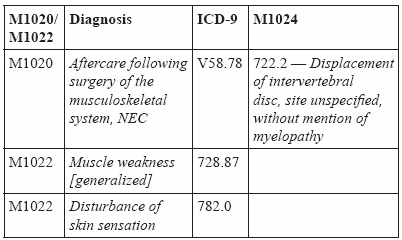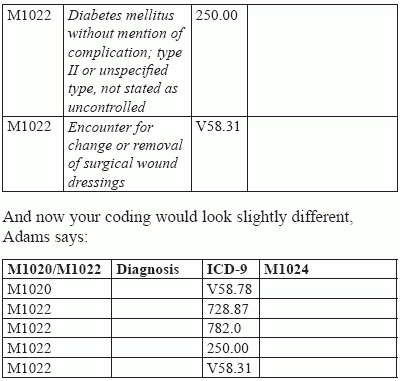Keep Close Watch on Non-Diagnosis Case Mix Items
M1024 changes shine a spotlight on OASIS accuracy.
By now you’re well aware that since Jan. 1, under the 2013 Home Health Prospective Payment System, you are only able to report acute fracture codes in M1024. In announcing the grouper changes, the Centers for Medicare & Medicaid Services indicated that they expected little change in case mix as a result.
CMS’ prediction may be true, but only for agencies with a thorough understanding of how to answer the case mix-generating OASIS items accurately. And that means looking well beyond M1020/M1022/M1024.
Take Note of Other Case Mix Items
While the OASIS diagnosis items are often considered the most important of the case mix items, in many situations, the majority of case mix points actually come form other clinical and functional items, says Judy Adams, RN, BSN, HCS-D, HCS-O, with Adams Home Care Consulting in Asheville, N.C.
Note: See the Case Mix Adjustment and Variable Scores table at http://www.selmanholman.com/docs/2012Table3CaseMixAdjrev12.pdf for a breakdown of the OASIS/Diagnosis interactions required to earn case mix points.
For example: Patients with multiple pressure or stasis ulcers do not receive any case mix points for those diagnoses. Instead, the points come from other diagnoses that might impact the plan of care and the other clinical and functional items that predict resource use, Adams says.
Scenario: Suppose your patient has two closed stage three pressure ulcers on the hip and a current stage two pressure ulcer on the coccyx. You’ll earn three case mix points for having two or more stage three pressure ulcers in M1308 — Current Number of Unhealed (non epithelialized) Pressure Ulcers at Each Stage, Adams says. You’ll also garner an additional five points for a stage two pressure ulcer as the most problematic. This gives you a total of eight points within just those two items, she says.
And that’s not all. You can earn additional points from other clinical items plus the activities of daily living (ADL) scores for functional activities, Adams points out.
Consider this Case Mix Comparison
Paying close attention to OASIS accuracy in other case mix areas can help prevent loss of points. No longer being able to report the resolved conditions underlying surgery in M1024 was one of the biggest concerns home health coders voiced when the PPS changes were announced. But were these fears warranted?
Case Example: Take a look at how your coding differs for an aftercare for orthopedic surgery patient. Mr. Smith was referred to your agency for skilled nursing and physical therapy following a diskectomy to correct a herniated disc. Nursing will provide post-surgical care and therapy will address weakness and numbness in his right leg. Mr. Smith also has diabetes which has been managed with oral hypoglycemics. His surgical wound is approximated, but with minimal serosanguineous drainage. Mr. Smith has functional limitations that result in the need for assistance to dress his lower body, intermittent assistance with bathing, minimum assistance with transfers, and assistance with ambulating on stairs and uneven surfaces (F2). You have orders for nine therapy visits.
In 2012, you would have coded for this patient as follows, Adams says:
Plus, your patient doesn’t meet the interaction criteria to earn points for an Ortho 2 diagnosis, according to PPS grouper logic. The patient isn’t receiving infusion therapy or parenteral nutrition, so he does not meet all the requirements needed for an Ortho 2 diagnosis to earn case mix points, Adams says. You wouldn’t have received these case mix points in 2012, either, she notes.
Instead, this patient’s case mix points break down as follows, Adams says: Three points for diabetes as a secondary diagnosis and four points for a non-healing wound healing by primary intention which totals seven clinical points (C2). The six Functional points (F2) and nine therapy visits add up to a C3 in service Utilization.
Bottom line: Provided the OASIS responses accurately capture the patient’s clinical and functional limitations, your payment for this patient will remain the same in 2013 as in 2012.

Your patient’s surgery resolved his herniated disc, reported in M1024 with 722.2 before the 2013 PPS changes. As a result, displacement of intervertebral disc without mention of myelopathy is a resolved diagnosis and it can no longer be claimed as a case mix diagnosis, Adams says.

